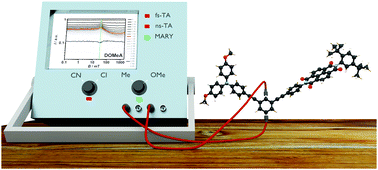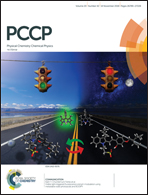Fine tuning of electron transfer and spin chemistry parameters in triarylamine–bridge–naphthalene diimide dyads by bridge substituents†
Abstract
The photoinduced charge separation and charge recombination in a set of four molecular dyads consisting of a triarylamine donor and a naphthalene diimide acceptor were investigated by time resolved transient absorption spectroscopy with fs and ns time resolution. In these dyads the donor and acceptor are bridged by a meta-conjugated diethynylbenzene bridge whose electronic nature was tuned by small electron donating (OMe, Me) or electron withdrawing (Cl, CN) substituents. While the formation of the transient charge separated states is complete within tens of ps, charge recombination is biphasic with a shorter component of several hundred ns and a longer component of several microseconds. This behaviour could be rationalized by assuming an equilibrium of singlet and triplet charge separated states. Magnetic field dependent measurements showed a strong influence on the biphasic decay kinetics and also a pronounced level crossing effect in the magnetic field affected reaction yield (MARY) spectra caused by a significant exchange coupling. An analysis of the observed kinetics using classical kinetic rate equations yields rate constants for charge separation and charge recombination as well as the exchange interaction splitting in the radical ion pair, all of them showing a delicate dependence on the bridge substituents.



 Please wait while we load your content...
Please wait while we load your content...